In which your blogger admits to great stupidity
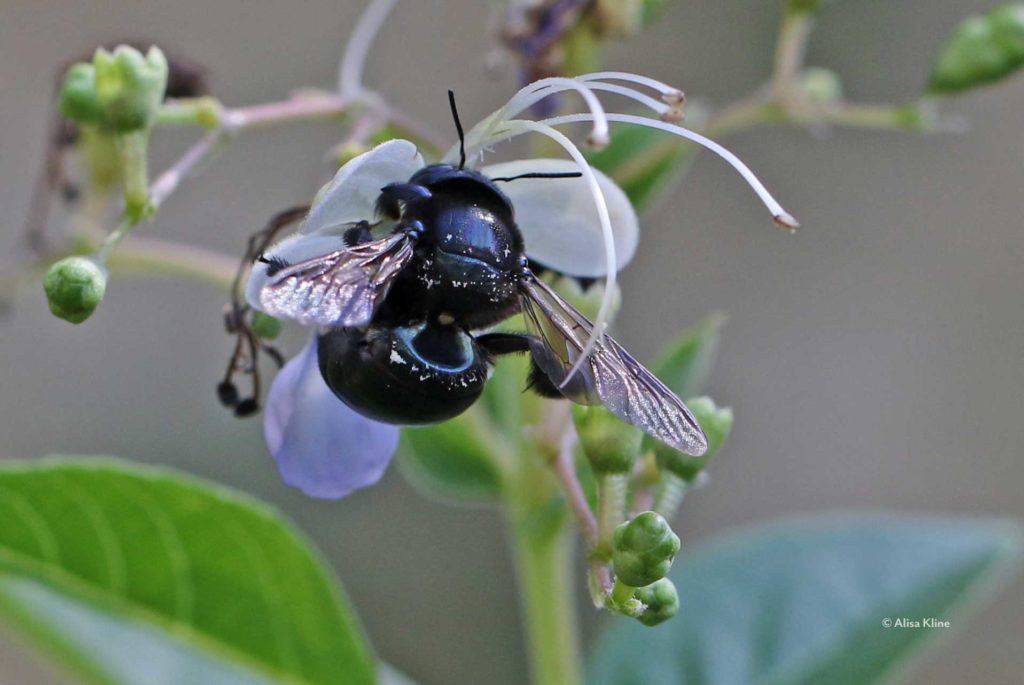 Anyone who spends time with this blog will know that there is a special place in my heart for native bees. So when one of these ladies worked her way onto the screened porch area of this small private nature preserve, I knew I had to save her.
Anyone who spends time with this blog will know that there is a special place in my heart for native bees. So when one of these ladies worked her way onto the screened porch area of this small private nature preserve, I knew I had to save her.
I had in my hand a dish towel. One usually does not try to capture a bee in a dish towel, but I have spent so very much time standing nose to nose with bees that I decided the towel approach would work.
It didn’t.
I want to say, right now, that everything I did from this point until her eventual release was stupid, but I did learn a lot about carpenter bees.
The first thing I learned is that carpenter bees do not use buzz pollination simply for pollination.
Digression
This might be a good time to note that “pollinators” are uninterested in pollination. They are trying to eat and feed their young. As a byproduct of this activity, plants get pollinated. Both the plant and the pollinators are acting on the same set of instructions: stay alive (that means eat and don’t get eaten) and reproduce. Bees want nectar (what they eat) and pollen, which they use primarily as food for their offspring (reproduce) although they will nibble the high-protein grains from time to time. Plants handle the eating part through photosynthesis. But because the plant cannot move, the reproduction part requires outside assistance. From this perspective, bees are sex workers.
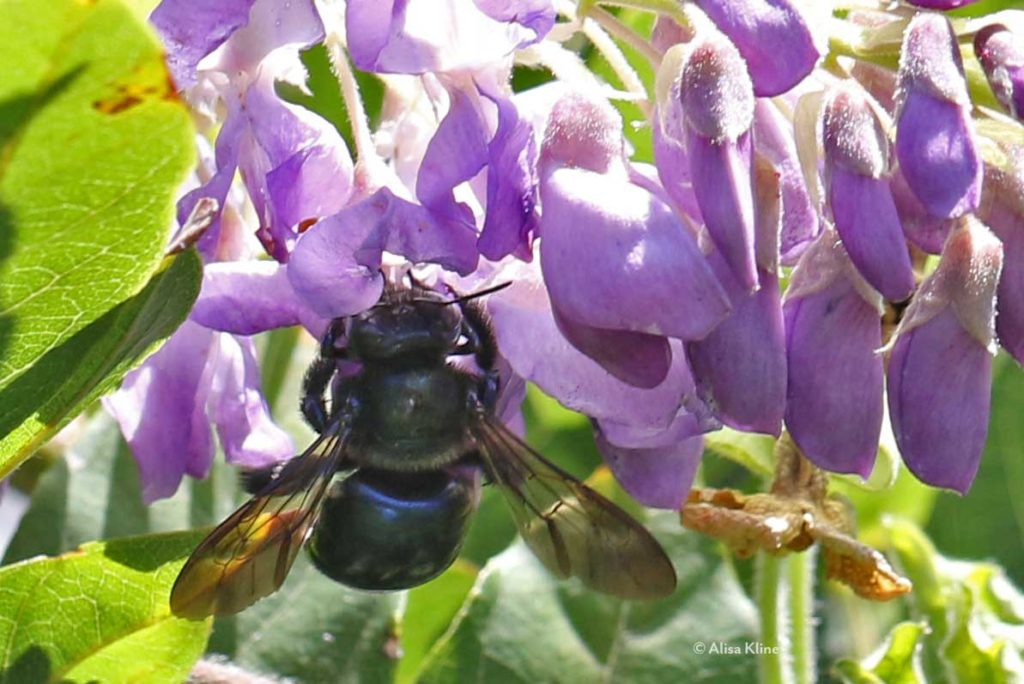
This carpenter bee is helping the wisteria (ahem) make whoopie.
Each plant has to lure a mobile creature close enough that it can toss some pollen on it and close enough that if any usable pollen is already on the creature, that the plant can grab it. So, the plant dangles something the other creature wants: sugar water.
A few weeks ago, this blog took a look at nectar robbing. When a carpenter bee can’t fit down the narrow tube that the plant uses to get an insect near the pollen, a carpenter bee can simply drill a hole into the nectar pool thus eating without encountering any plant sexual organs at all. She eats for “free.”
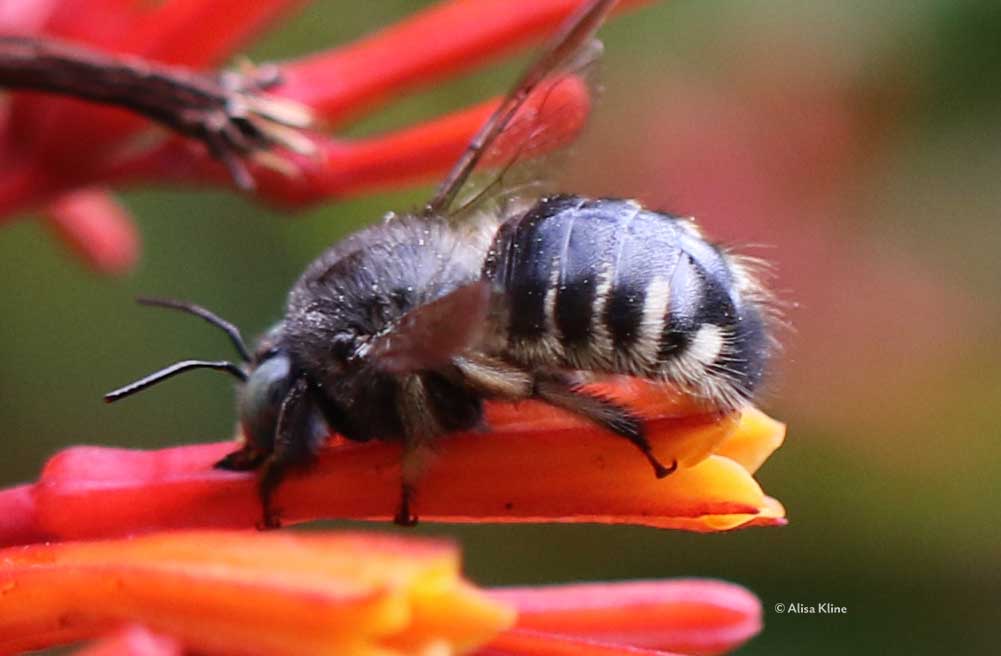
This carpenter bee has chewed a hole in the flower of this hamelia patens and has stuck in her whole mouth, up to her eyeballs. Nectar robbing par excellence!
But when a plant is specially designed to be pollinated by big insects (like carpenter bees), everything goes like clockwork for all involved!
Clerodendrum ugandese grows on the preserve. It isn’t native. The ugandese is supposed to indicate the plant is native to Uganda, but in fact, it comes from Keyna. Either way, it’s not native here. But bees love it.
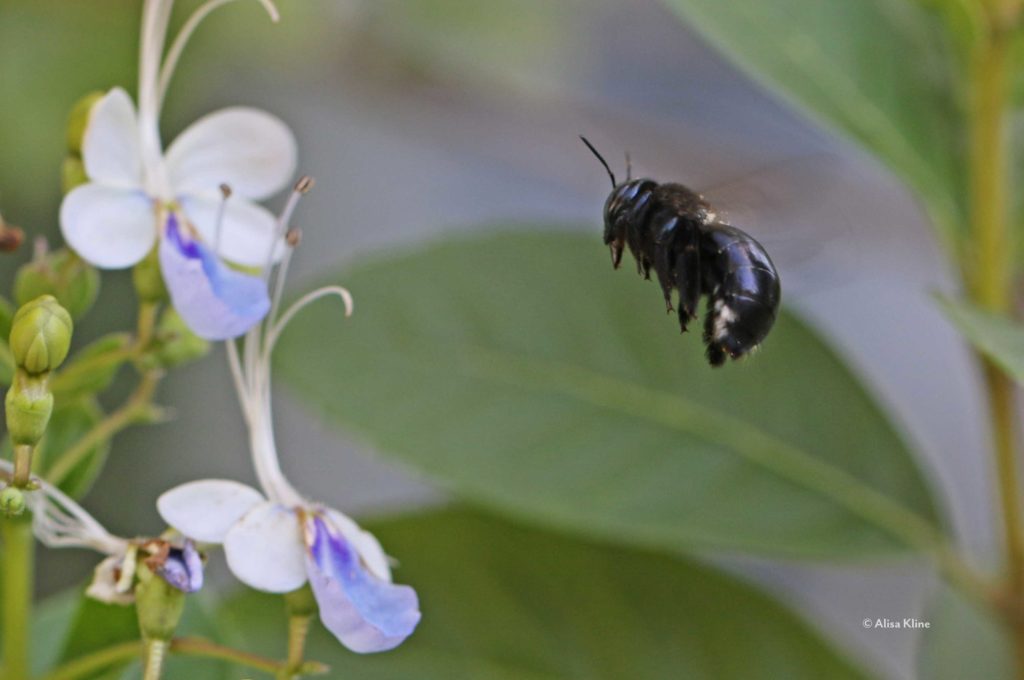
This female southern carpenter bee is approaching a cleradendrum flower. Her mouth parts are already extended. She’s ready to eat!
It might as well be specially built to be pollinated by carpenter bees. The anthers (sperm producing organs) are on the long filaments that curl from the top of the flower. One of the filaments is lower than the others. That one bears the sperm-receiving organ (stigma).
When a big bee comes in, she lands on the darker blue lower petal. That weighs down the flower and tips the filaments downward towards the bee. Some pollen gets knocked out of the anthers and lands on the bee’s back. The stigma, lower than the anthers, drags across the bee’s back as she enters, picking up any useful pollen the bee might have brought along.
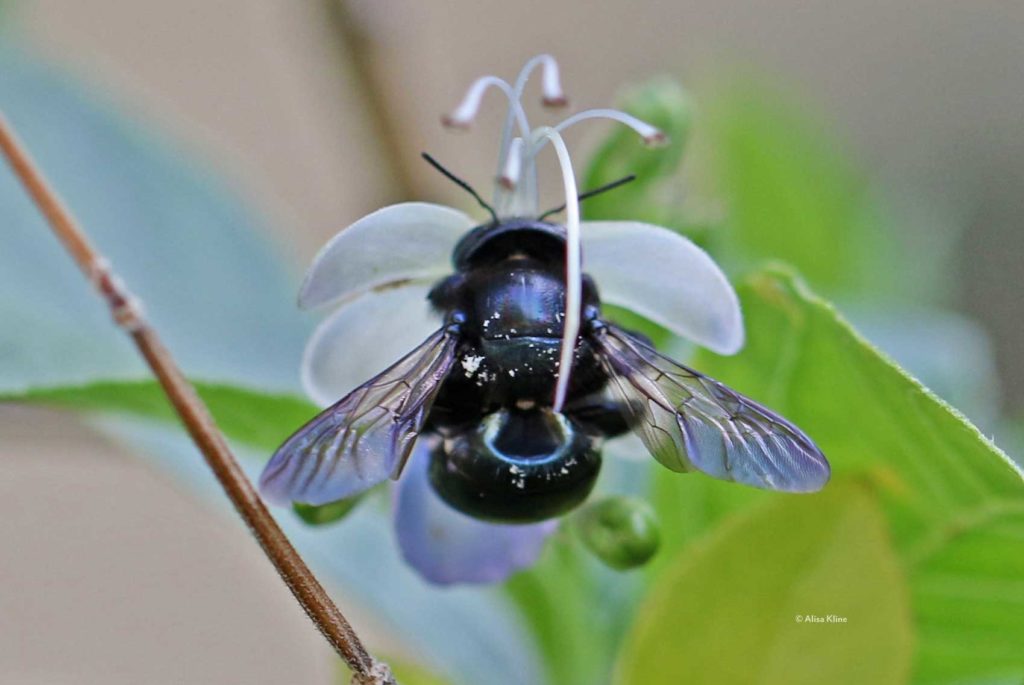
You can see the dusting of pollen along the bee’s back and the pistil, topped by its stigma, draping almost touching the bee. She will bump into it as she exits if she hasn’t already.
Back to the main story
Buzz pollination is used by some species of bees to gather large quantities of pollen. Some plants have adapted themselves to have pollen that can only be accessed easily by a bee who can do the buzz. To perform the buzz, the bee grasps the anthers, but these anthers have the pollen inside a tube, not on the surface. If the bee uses its flight muscles to set up a vibration at exactly the right frequency, the plant releases a huge amount of pollen.
These plants do not offer any nectar. But bumblebees and carpenter bees need large amounts of pollen to make loaves of bee bread that they will leave behind for each of their offspring so that when they emerge from their eggs, they have plenty to eat.
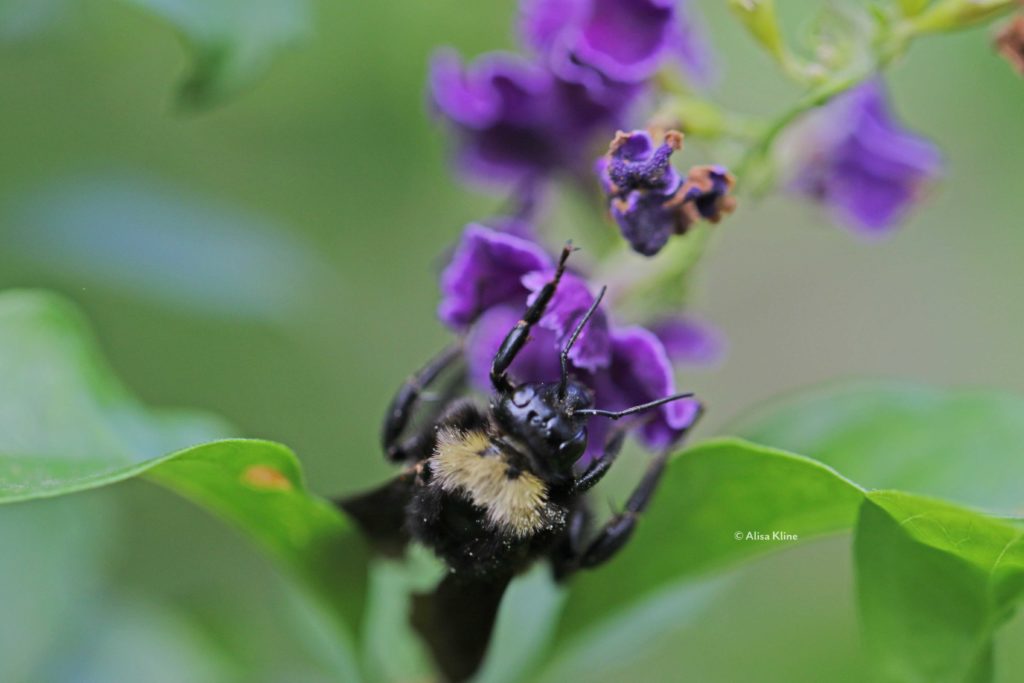
This American bumblebee is not buzz pollinating this duranta flower, but she is one of the types of bees who specialize in buzz pollination. This makes bumblebees in great demand by farmers growing tomatoes, eggplants, and related crops; they are best pollinated by buzzing.
For these bees, the shower of pollen for very little time investment is worth not getting any nectar. From the plant’s point of view, it saves energy by not making nectar. Most insects won’t visit, but those that really value the pollen will visit often because there is little competition for the bounty offered.
What does this have to do with a carpenter bee stuck on the screened porch? I thought you’d never ask.
I scooped the bee up in the towel and she immediately, within the confines of my closed hand, began the buzz. It was like one of those restaurant pagers going off. I was so startled that I released the bee.
My second effort at capture continued with the towel, but now, I was kind of frustrated and tried to use the towel to move her to a spot I could grab her more easily. From the bee’s perspective, I was trying my damnedest to kill her. So, when I did manage to grab her again, she stung me through the dish towel, prompting her second escape and knocking some sense into me.
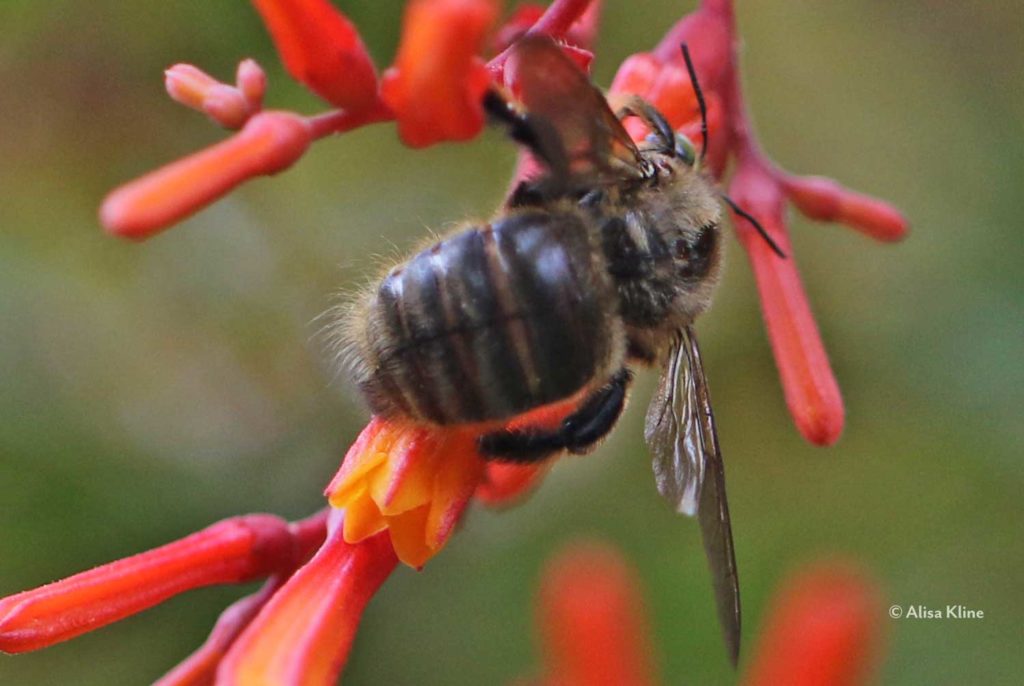
The bee with whom I wrestled looked a great deal like this one. He is a Strand’s carpenter bee.
I went and got a glass and a piece of paper and within a minute she was free.
Lessons learned (besides that I really am pretty stupid).
First, I learned that bees use their buzz effect for defense. There is some mention of this in the literature, but I couldn’t find much and only with regard to bumblebees. But I can assure you that they do vibrate when their life is threatened (or trying to be saved, which looks kind of the same to you if you’re a bee).
I also (belatedly) realized that carpenter bees also use the loud vibration to intimidate others. I take a lot of photos of bees. To accomplish this, I stand very still for long periods of time right in the middle of a very tempting natural food source. After a while, I become part of the furniture and everyone goes back about their business.
But, sometimes, a bee will decide to investigate me more carefully. This bee will fly right into my face and make a buzzing sound. It will buzz hover a foot or so away for a little while and then go on about its business. I always imagined that they were trying to see if I was a flower (oh, how we flatter ourselves). But I should have realized that they fly around me all the time and I only hear that buzzing noise when one of them is doing the hover thing. That bee is threatening me! Since I don’t engage, the bee loses interest pretty quickly.
The end of stupid (please)
The sting hurt, but not unbearably. And, unlike honeybees, carpenter bees’ stingers aren’t barbed, so they don’t tear their guts out when they sting you. They just move along.
The sting told me an important fact about the bee. It told me that she was a she. Male bees do not sting. They might want to, but a stinger is an adaptation of an ovipositor, the organ through which a bee lays eggs. Only girls lay eggs; only girls can sting.
I wasn’t thinking about identifying the bee while I was chasing it. Clearly, I wasn’t thinking much at all. But once it was over, I realized that I didn’t know what type of bee I had. She wasn’t one of the familiar ones. So, I have spent the last few weeks inspecting the local bees very closely. (Hence all these photos!)
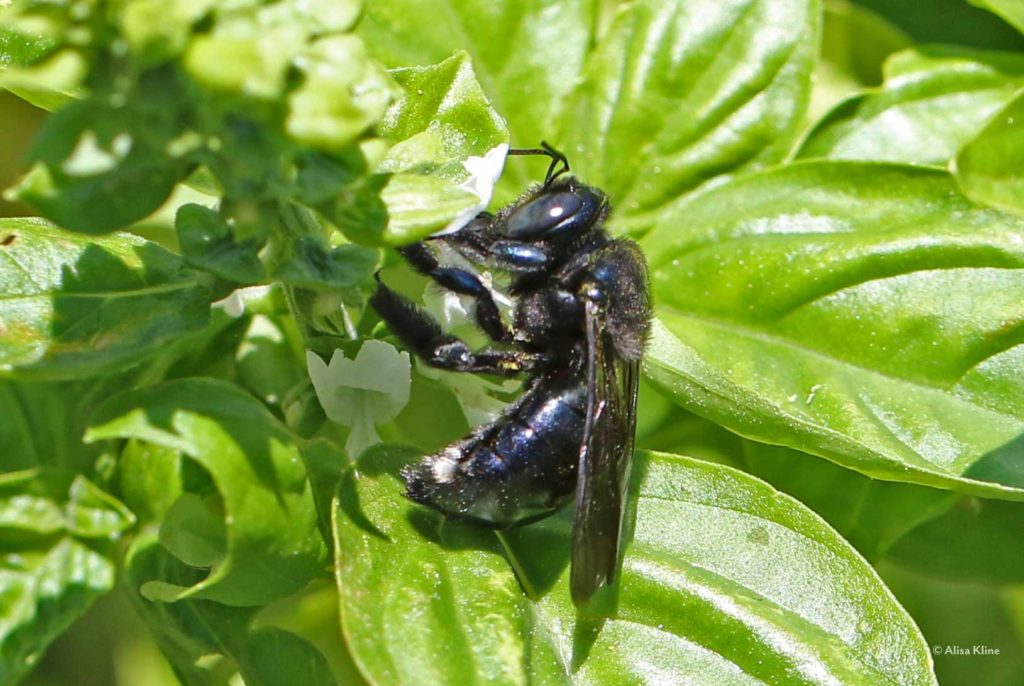
This female southern carpenter bee is nectar robbing some basil.
I think the miscreant was a Strand’s carpenter bee. Like the one a few photos up, but that is a male. The female looks only slightly like him, being much darker and without the lovely yellow lines on her face. But I’m pretty sure. There really aren’t that many types of carpenter bees that size. The Strand’s is one that is much less common on the preserve. So of course, it would be her. I hope she doesn’t tell the others about the insane woman behind the screens.

